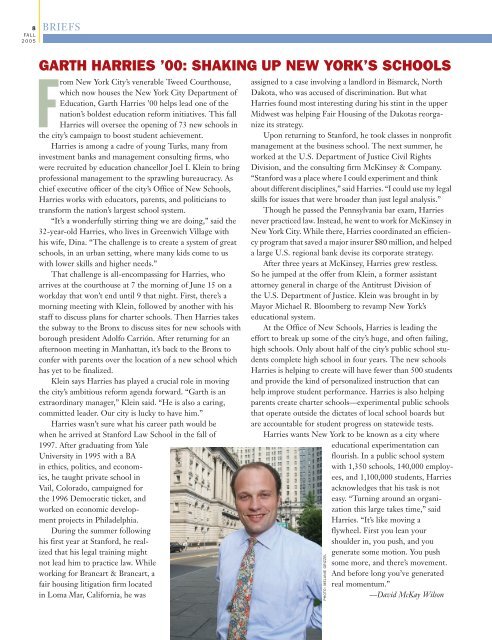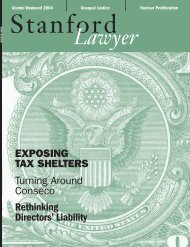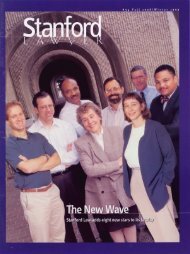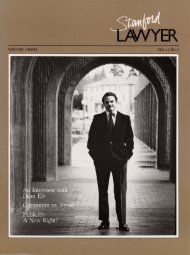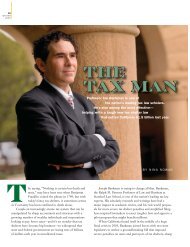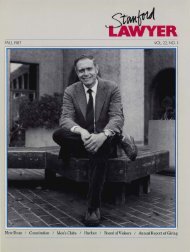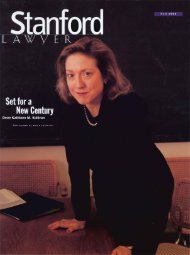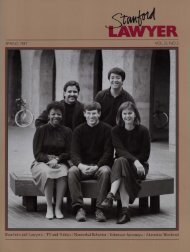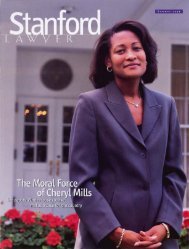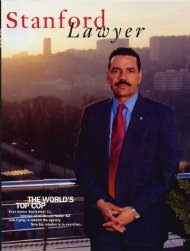Issue 73 - Stanford Lawyer - Stanford University
Issue 73 - Stanford Lawyer - Stanford University
Issue 73 - Stanford Lawyer - Stanford University
You also want an ePaper? Increase the reach of your titles
YUMPU automatically turns print PDFs into web optimized ePapers that Google loves.
8<br />
FALL<br />
2005<br />
BRIEFS<br />
GARTH HARRIES ’00: SHAKING UP NEW YORK’S SCHOOLS<br />
From New York City’s venerable Tweed Courthouse,<br />
which now houses the New York City Department of<br />
Education, Garth Harries ’00 helps lead one of the<br />
nation’s boldest education reform initiatives. This fall<br />
Harries will oversee the opening of <strong>73</strong> new schools in<br />
the city’s campaign to boost student achievement.<br />
Harries is among a cadre of young Turks, many from<br />
investment banks and management consulting firms, who<br />
were recruited by education chancellor Joel I. Klein to bring<br />
professional management to the sprawling bureaucracy. As<br />
chief executive officer of the city’s Office of New Schools,<br />
Harries works with educators, parents, and politicians to<br />
transform the nation’s largest school system.<br />
“It’s a wonderfully stirring thing we are doing,” said the<br />
32-year-old Harries, who lives in Greenwich Village with<br />
his wife, Dina. “The challenge is to create a system of great<br />
schools, in an urban setting, where many kids come to us<br />
with lower skills and higher needs.”<br />
That challenge is all-encompassing for Harries, who<br />
arrives at the courthouse at 7 the morning of June 15 on a<br />
workday that won’t end until 9 that night. First, there’s a<br />
morning meeting with Klein, followed by another with his<br />
staff to discuss plans for charter schools. Then Harries takes<br />
the subway to the Bronx to discuss sites for new schools with<br />
borough president Adolfo Carrión. After returning for an<br />
afternoon meeting in Manhattan, it’s back to the Bronx to<br />
confer with parents over the location of a new school which<br />
has yet to be finalized.<br />
Klein says Harries has played a crucial role in moving<br />
the city’s ambitious reform agenda forward. “Garth is an<br />
extraordinary manager,” Klein said. “He is also a caring,<br />
committed leader. Our city is lucky to have him.”<br />
Harries wasn’t sure what his career path would be<br />
when he arrived at <strong>Stanford</strong> Law School in the fall of<br />
1997. After graduating from Yale<br />
<strong>University</strong> in 1995 with a BA<br />
in ethics, politics, and economics,<br />
he taught private school in<br />
Vail, Colorado, campaigned for<br />
the 1996 Democratic ticket, and<br />
worked on economic development<br />
projects in Philadelphia.<br />
During the summer following<br />
his first year at <strong>Stanford</strong>, he realized<br />
that his legal training might<br />
not lead him to practice law. While<br />
working for Brancart & Brancart, a<br />
fair housing litigation firm located<br />
in Loma Mar, California, he was<br />
assigned to a case involving a landlord in Bismarck, North<br />
Dakota, who was accused of discrimination. But what<br />
Harries found most interesting during his stint in the upper<br />
Midwest was helping Fair Housing of the Dakotas reorganize<br />
its strategy.<br />
Upon returning to <strong>Stanford</strong>, he took classes in nonprofit<br />
management at the business school. The next summer, he<br />
worked at the U.S. Department of Justice Civil Rights<br />
Division, and the consulting firm McKinsey & Company.<br />
“<strong>Stanford</strong> was a place where I could experiment and think<br />
about different disciplines,” said Harries. “I could use my legal<br />
skills for issues that were broader than just legal analysis.”<br />
Though he passed the Pennsylvania bar exam, Harries<br />
never practiced law. Instead, he went to work for McKinsey in<br />
New York City. While there, Harries coordinated an efficiency<br />
program that saved a major insurer $80 million, and helped<br />
a large U.S. regional bank devise its corporate strategy.<br />
After three years at McKinsey, Harries grew restless.<br />
So he jumped at the offer from Klein, a former assistant<br />
attorney general in charge of the Antitrust Division of<br />
the U.S. Department of Justice. Klein was brought in by<br />
Mayor Michael R. Bloomberg to revamp New York’s<br />
educational system.<br />
At the Office of New Schools, Harries is leading the<br />
effort to break up some of the city’s huge, and often failing,<br />
high schools. Only about half of the city’s public school students<br />
complete high school in four years. The new schools<br />
Harries is helping to create will have fewer than 500 students<br />
and provide the kind of personalized instruction that can<br />
help improve student performance. Harries is also helping<br />
parents create charter schools—experimental public schools<br />
that operate outside the dictates of local school boards but<br />
are accountable for student progress on statewide tests.<br />
Harries wants New York to be known as a city where<br />
educational experimentation can<br />
flourish. In a public school system<br />
with 1,350 schools, 140,000 employees,<br />
and 1,100,000 students, Harries<br />
acknowledges that his task is not<br />
easy. “Turning around an organization<br />
this large takes time,” said<br />
Harries. “It’s like moving a<br />
flywheel. First you lean your<br />
shoulder in, you push, and you<br />
generate some motion. You push<br />
some more, and there’s movement.<br />
And before long you’ve generated<br />
real momentum.”<br />
—David McKay Wilson<br />
PHOTO: MELANIE GRIZZEL


